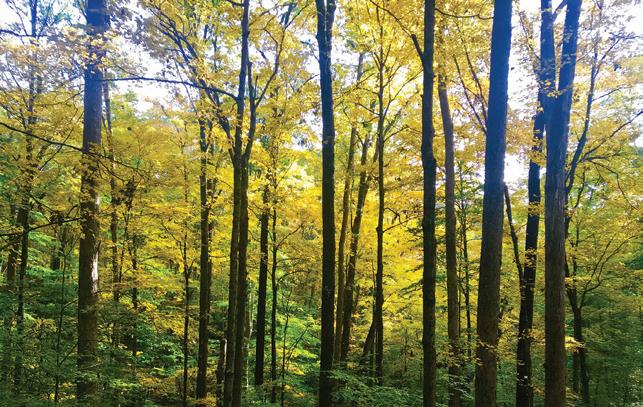3 minute read
Field Notes: Transition
Next Article
~by Jim Eagleman

Autumn, the season that teaches us that change can be beautiful.
The end of summer, with a long and humid portion of the year still with us, signals a time of slow but methodical preparation for many birds and animals. I watch for trademark signs of dwindling daylight, the cool of autumn mornings, and long shadows of early evening. My love of summer and all it brought to the natural world, slowly fades.
I still yearn to hear the flute-like calls of a wood thrush chorus, but the birds all depart my woods by mid-August. I’m grateful they keep coming back here, especially since I learned of their most faraway South American destination.
Tall jewelweed and clumps of self-heal flowers are replaced with asters and goldenrods of different kinds. The phlox and woodland sunflower now stand as seed dispensaries, while ironweed and joe-pye grow tall. My milkweeds, slow to flower in shade and bent over with every rain, won’t show deposited monarch eggs until they mature. This is their second year in my woodland border. If color alone is what these woodland plants bring, I’m content with them occupying space. But hummers, dragonflies, solitary bees, and flies found them as food. The low hum of wings made me stop. I can’t be a lover of flowering native plants without a nod to pollinators.
Daytime background sounds during each late summer day remain strong. Pulsating cicadas and wood peewees keep pace with an unrelenting, red-eyed vireo. A solo bluejay calls from the ravine. Katydids with their “chutsh-chutsh” and low-flying lighting bugs are regulars, an entertaining ritual each evening at dusk. Spending those summer evenings on a deck surrounded by woods is the perfect way to wind down.
Last fall’s squirrels and chipmunks responded to a bumper crop of mast: the acorns, walnuts, and beech nuts in our woods. Now they are now absent. Falling hickory nuts on our porch roof are less noisy. Not always do bountiful food sources mean birds and animals respond accordingly. It would be a less chaotic world if everything in nature was synchronized; it isn’t, and change happens.
If I take all these things for granted, anticipating them as regular occurrences each year, I fail to take into account changes that can happen. I think of changes in my own life and see some disruptive, others welcomed. I wouldn’t like dependable things to change—a reliable car, a comfortable bed—but I would like new t-shirts to replace old ones, maybe a different color on a screen door. Things that work, unfailing, trusty, shouldn’t change. I’ll replace the things that don’t.
“Change is inevitable”, said a professor years ago. This after a class discussion on predator-prey. Things that affect survival are called limiting factors: disease, accidents, hunting, weather, and they have more impact than we realize. “And each of these can change over time”, he added. Dynamic relationships in nature, complicated, often surprising in complexity, take time to understand and I’m still learning.

